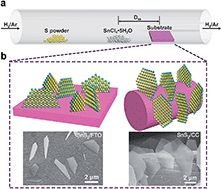Vertically aligned two-dimensional SnS2 nanosheets with a strong photon capturing capability for efficient photoelectrochemical water splitting†
Abstract
Two-dimensional (2D) metal dichalcogenides have emerged as attractive materials for application in photoelectrochemical (PEC) water splitting due to their unique structure and strong interaction with light. To date, deposition of exfoliated 2D nanosheet dispersions onto conductive substrates by a variety of techniques (e.g. casting, spin-coating and self-assembly) has been the most exploited approach to fabricate photoelectrodes from these materials. However, such solution processing strategies do not allow for control over the flake orientation and formation of intimate electrical contacts with conductive substrates. This could negatively affect the PEC efficiency. Herein, we demonstrate, for the first time, vertically aligned 2D SnS2 nanosheets with controllable growth and density on conductive substrates (FTO and carbon cloth (CC)) by a modified chemical vapor deposition (CVD) method. In PEC measurements, these vertically aligned 2D SnS2 nanosheet photoelectrodes exhibit a high incident photon to current conversion efficiency (IPCE) of up to 40.57% for SnS2⊥CC and 36.76% for SnS2⊥FTO at 360 nm, and a high photocurrent density of up to 1.92 ± 0.01 mA cm−2 for SnS2⊥CC and 1.73 ± 0.01 mA cm−2 for SnS2⊥FTO at 1.4 V vs. reversible hydrogen electrode (RHE). These values are two times higher than that of their photoelectrode (SnS2//FTO) counterparts prepared by conventional spin-coating. Our demonstration of this controllable growth strategy offers a versatile framework towards the design and fabrication of high performance PEC photoelectrodes based on 2D metal chalcogenides.


 Please wait while we load your content...
Please wait while we load your content...